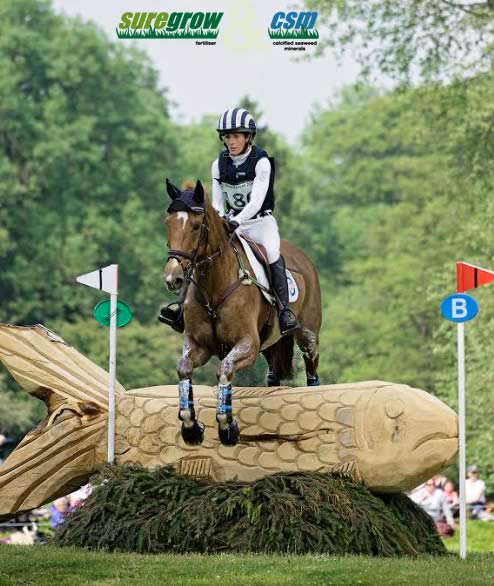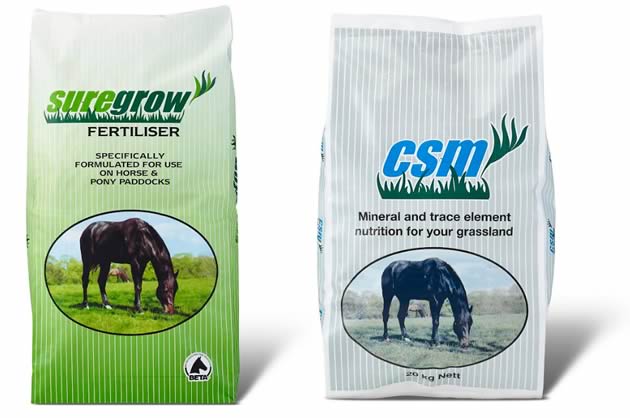
Horseytalk.net Special Interview
Caroline Powell
Suregrow sponsored rider Caroline Powell guides us through walking a cross-country course with tips and advice on how she prepares to tackle tracks at all levels.

Tackling a Cross-Country Course with Caroline Powell
Confidence is the key when it comes to cross-country, knowing that you and your horse can do it and have faith in each other throughout the round.
When walking the cross-country course it is important to look at the lines to take to each fence and the quickest way to get there safely. Not only will it help you to save valuable time but by presenting your horse well to each fence, when he is balanced and on a good line, trust and confidence between horse and rider will be established and maintained.
A good approach to every fence is paramount in building confidence. The rider needs to keep the horse between hand and leg and the horse needs to know that you want him to jump. When you approach a fence your body language will change and your horse will know there is a fence to be jumped.

Sitting up, and using a big positive half halt to bring your horse back together will change his canter making him bouncier, shorter and more in balance to face a fence. Knowing when and where to prepare for a jump will give you a strong basis to tackle any obstacle.
Shifting your weight and telling your horse there's a jump coming, is important especially when your horse has been galloping. You will need a shorter stride to tackle a technical fence. Making sure you are familiar with the fences and course as a whole is therefore of paramount importance when preparing to ride across country.
Many riders have superstitious habits, like having to cross the start and finish gates when walking the course, but starting your course walk in the start box will give you an idea of the distance you have to the first fence and how straight your line to it can be. Getting a good start over the first couple of fences is very important as it will help you to establish a rhythm and get you and your horse in a good frame of mind.
Accuracy is vital, with a good square approach the horse will have less inclination to run out and will focus on the fence. The length of your straight approach depends on your horse's level of experience; younger horses may need a longer approach to a fence but older more experienced horses may only need a couple of strides to set themselves up.
Pick your line when walking the course, find a marker on the course to turn from and look for a point in the distance to focus on. This will help you to ride straight over and onwards after the fence.
When riding combination fences, ride to the last element, still bearing in mind the line you will take over the combination as a whole. If a combination fence features water, be prepared that the horse may slow up, so focus on a good positive forward stride to the last fence and beyond.
Stride out related distances to help you decide how to ride them, either on fewer and longer strides or more and shorter ones. Again, knowing your horse is important; his size, the length of his stride and his level of fitness are all factors to bear in mind. It's important to see a stride and go for it.
Every course is different, and the conditions on the day maybe different again. Consider the going and the terrain; is it flat, hilly or undulating? Bear in mind the level of fitness of your horse and the time of your cross country round, will the ground have deteriorated throughout the day before your round? Consider these factors when choosing your lines to fences.
You should also establish where the most difficult fences are situated and whether your horse will be fresh or tired when he gets to them. When you are close to the end of the course your horse will be getting very tired so it's even more important to ride positively, get your approach and lines between each fence spot on.
When walking a course it is easy to feel nervous about the size or look of the fences. Some fences can look really wide when you walk the course but when you compare them to the width of a horse's gallop stride you'll see that they're not so bad.
Gage your own strengths and weaknesses, picking the best line for you and your horse will help you save time or give you the best chance of a clear. If you are anxious about a fence walk it again and again to get your lines dead right. I tend to walk larger courses at least three times, so I really know the course, if you are 100% confident in the exact route you and your horse will take you will both feel one step closer to that perfect cross country round.

Caroline's Favourite Product
Without doubt our paddocks have greatly benefited from the addition of Suregrow fertiliser.
The fertiliser contains major nutrients including Nitrogen, Phosphorous and Sulphur which are key elements required for grass growth.
Unlike other fertilisers, the horses do not need to be removed from the paddock during application, which eliminates the inconvenience of moving horses around into alternative grazing.
For more information on Suregrow please contact Suregrow on 01423 223045 or visit www.suregrowuk.com


